Tamiya Sports Car Series No. 24
Opel Astra V8 Coupe
1/24 scale
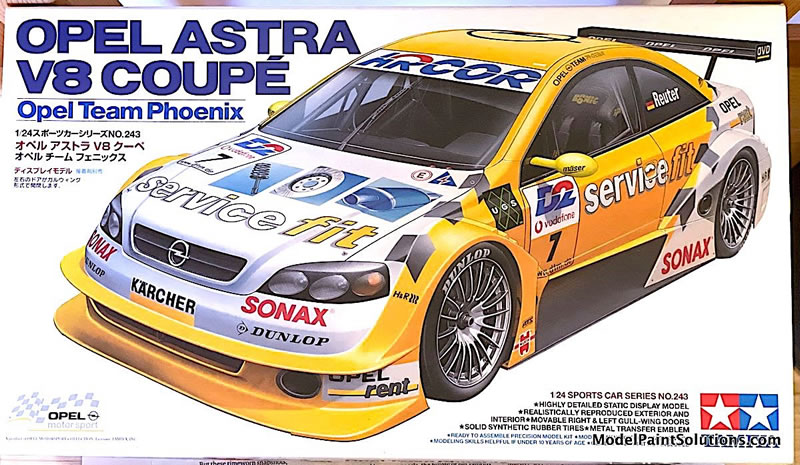
by Brad Huskinson

I was given this kit by Mike "The Weatherman" Millette, a member of our model building group. I was totally unaware of this car until then. I have followed many forms of racing including Formula 1 currently, Indy Cars, and Trans-Am way back, but not DTM racing in Europe. I thought it was pretty cool looking and wanted to give the two-tone paint job a try.

Coming off of a couple of unrewarding builds and needing something to change, I decided to build the Opel Astra box stock. No aftermarket parts, decals, etc. It had been a very long time since doing that. It definitely shortens the build time when you aren't constantly searching the web for this and that extra item. All parts were removed from the sprue with sprue cutters, and cleaned up with sandpaper, sanding sticks and a new addition, a ceramic bladed scraper. The ceramic scraper works great for removing mold lines and reduces the amount of sanding time considerably. X-Acto knives are also used extensively along with panel line cutters. This is the first kit that I have used scalpels on. The curved blade works really well for following seam lines and edges for cutting tape masks, etc. Similarly painted parts are grouped together to save painting and cleanup time. I used Tamiya Thin for unpainted parts and several different CA glues for the parts that had been painted. Occasionally I will use white glue for certain applications involving paper based items. Testors Clear Parts Cement for windows and other clear parts.
This Tamiya kit fit together perfectly, as most of them do. So little flash or mold lines that need special attention. One of the most impressive fits of the car were the headlights and taillights. They were mounted by angling them into a tab on the back of the light and pushing them into the opening. Perfect fit! Glue from behind. Super clean light surrounds without any sticky issues or distorted clear plastic.
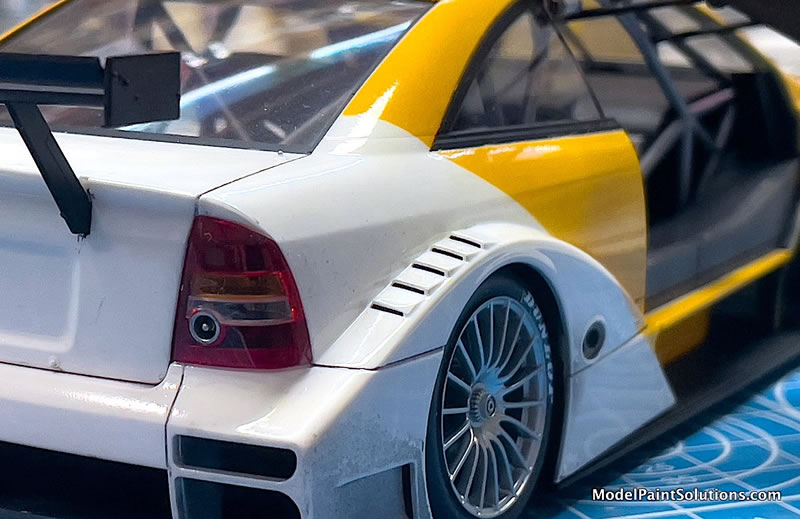

The only exception was the gull wing doors.
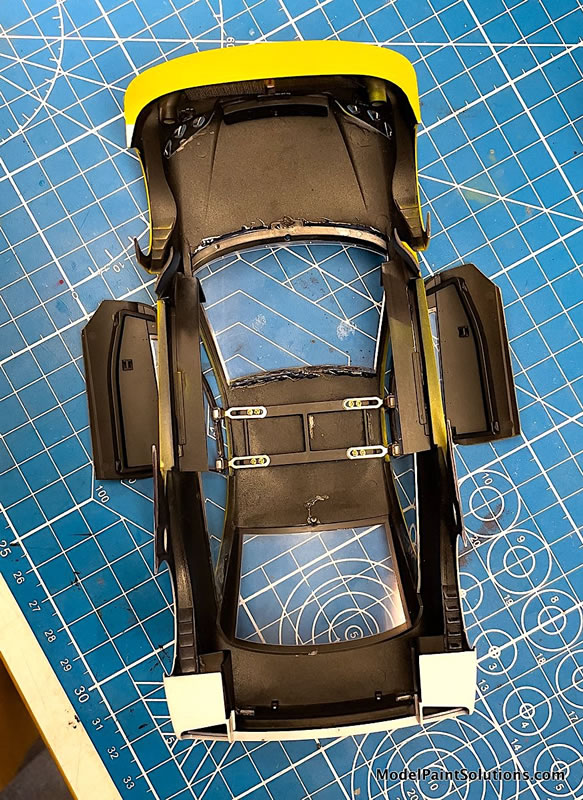
I couldn't get them to stay at the same exact height when propped open, which is a great way to display this particular car. The doors do not need to be glued in place. They can be shown closed or open just by attaching two clip-on arms to support them.
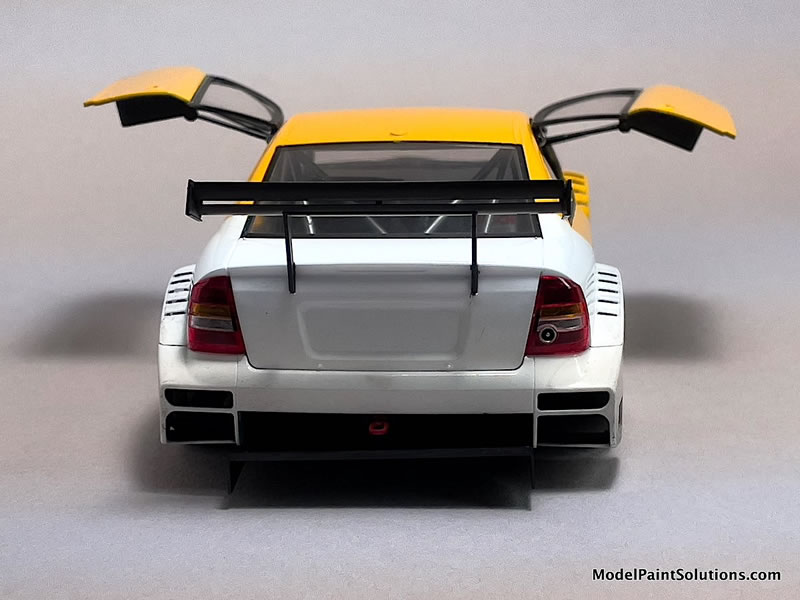
The Interior
The interior was very straight forward, even though it has a full roll cage. It went together so smoothly I was surprised. Most of the callouts for interior colors are for semi-gloss black. I tried mixing up some different shades just to give more visual interest. Most of the semi-gloss black was Mr. Finishing Surfacer 1500 from the rattle can. It is amazing paint that has a very nice smooth finish. I have used it frequently for black vinyl/leather seats. The sheen is spot on.

The interior of the body is also painted black, so I needed to mask the exterior to prevent black overspray.

The single seat and steering wheel were painted with AK Black 6RP mixed 65/35 with AK Flat White to replicate a nice charcoal suede leather effect.

Kit supplied brand-name decals were applied to the seat along with racing harness decals. Not the best looking seat belts. Should have made an actual harness. When all of that was dry, I flat coated the seat and steering wheel rim with Vallejo Acrylic Matt Varnish which finished the suede leather feel.
The roll cage was painted with Splash Paints Steel and the padding for the driver was brush painted with AK Black 6RP.

A Silver pigment ink pad and micro brush were used to highlight some edges in the interior where the paint would most likely get rubbed off. This quickly added some nice depth and realism to the interior.
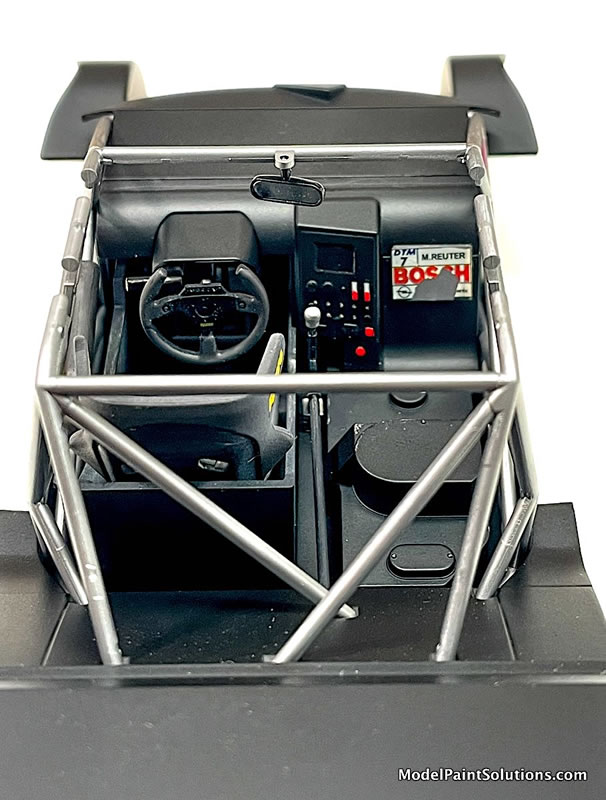
The details in the dashboard were painted using a toothpick to put red and other called out colors on the switches and knobs.

the kit came with very nice masks for the windows to allow easy painting of the black borders. Mr. Finisher Surfacer Black 1500 was airbrushed here.
Engine?
The kit is a curbside model, meaning no complete engine. There are some headers visible in the front wheel wells which then connect to pipes that run down the side of the car and vent out directly in front of the rear wheel wells. That's it. The hood does not open. The headers were heat stained using Tamiya clear blue, orange, yellow and red in layers, shot through a Harder & Steenbeck Infinity airbrush with a .15 needle.

Chassis/Wheels/Tires
The chassis is a flat panel hiding most everything above it. A bit of the steering mechanism shows from behind each front wheel. The chassis was painted Mr. Finishing Surfacer Black 1500 straight from the rattle can.
The disk brakes were airbrushed with a mix of 70% AK Xtreme Metallic Smoke/30% AK Xtreme thinner. I used Pueen Latex Tape (this is used in nail salons as a cuticle mask) to mask the rotors then airbrushed the hubs and calipers with AK Xtreme Duraluminum.

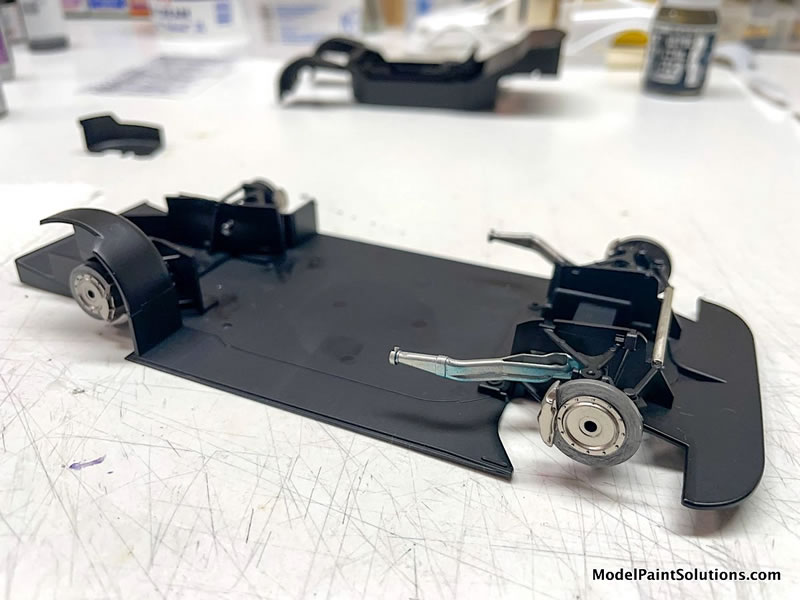
The wheels were really easy and fun to paint. They were airbrushed AK Xtreme Aluminum. The center hubs were masked by punching holes in yellow tape with a leather punch and airbrushed AK Xtreme Duraluminum. The difference is subtle, but definitely different tones. I like the look a lot.

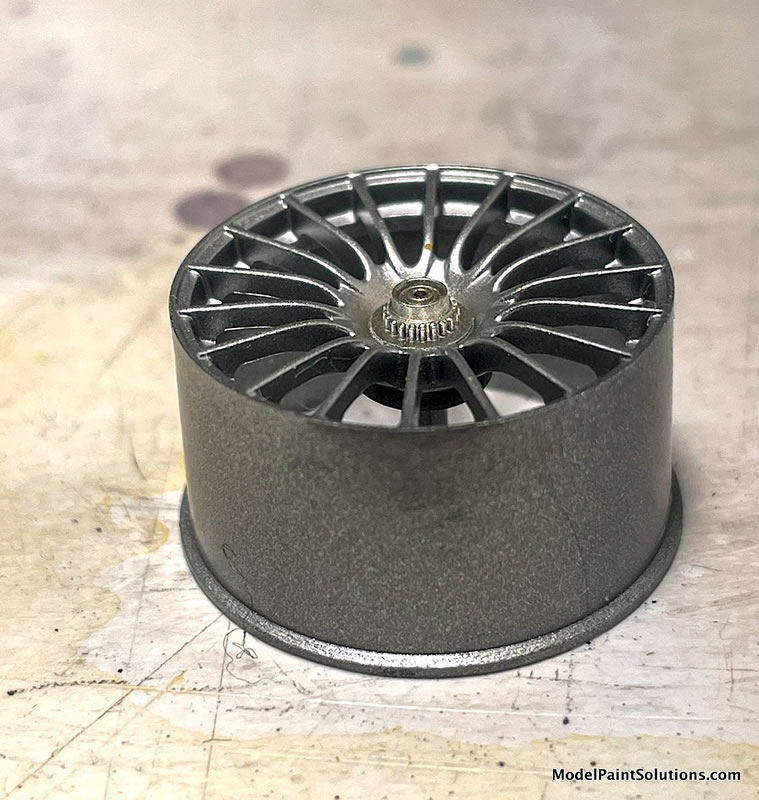
The tires are the treadless racing type that I spun on the drill jig I made to remove center line seams. Just clamp the tire and spin the drill while holding sandpaper or a sanding block against the tread. Depending on the tire material, you may have to reverse the drill to clean up some fuzzy residue. I also use the jig to give treaded tires an actual used look. The press on Dunlop decals were put on after mounting the tires on the wheels. I followed the instructions carefully with great success.
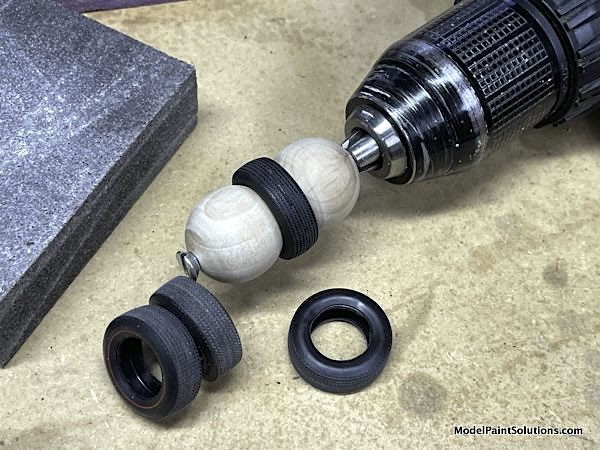
The Body
The body fit together perfectly. A bit of tape to hold the pieces together and a bit of capillary glue action and bingo! It’s a beautiful thing when that happens. No fighting warped or poor fitting pieces. There was just a minimal amount of mold seams that needed attention.The whole exterior was very lightly wet sanded with Profile Accessories Micromesh buffing cloths.
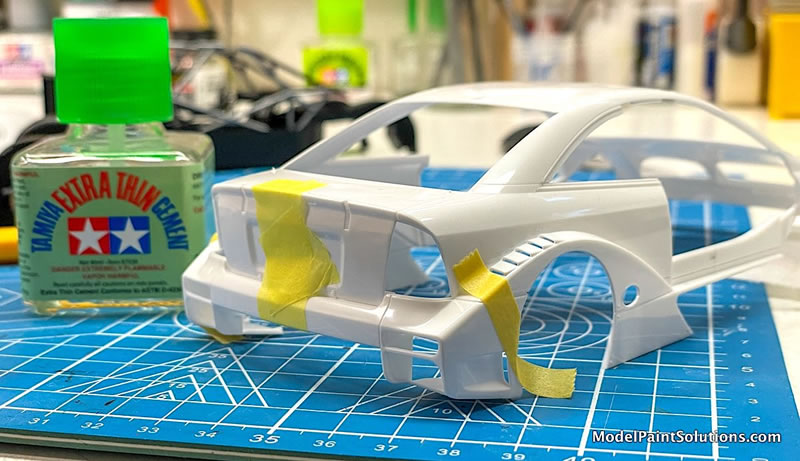
After masking the complete exterior, the interior of the body was airbrushed first with Mr. Finishing Surfacer 1500 Black. Then reversing the process, the interior was completely masked so that the exterior could be airbrushed with a Gaahleri Mobius 0.3 and decanted white Tamiya Fine Surface Primer. I have used this paint as the final white on several builds. After adding a clear coat, it looks great.

Being a two-tone color scheme meant that masks were needed to protect one color or the other. The kit came with a nice set of masks, but of course, I gummed up some paint and needed to do some re-masking and painting.

Fortunately my good friend Steve came to the rescue with his cutting machine and made me two new sets of masks.
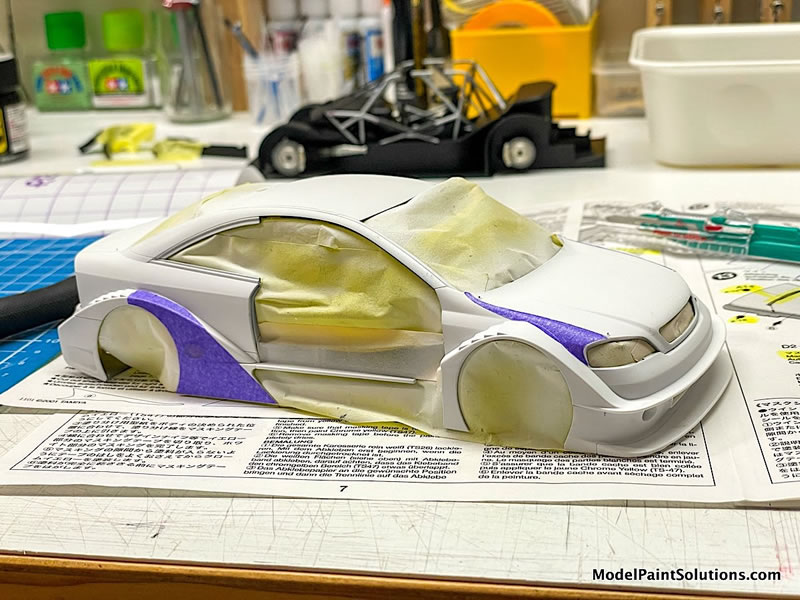
Now it was time to mask the white paint to put on the AK RC007 Yellow. The paint to thinner ratio was 40% paint/60% AK Nitro thinner with 5% Mr. Retarder Mild added.
It took 3-4 light coats to get the yellow looking right. My only real problem with the yellow paint was keeping the color density consistent. I apparently painted more coats on the doors which came out a darker yellow. I have since learned from talking to other modelers that yellow is a difficult color and that this is not uncommon.

The body was then clear coated with Splash 2K Clear. Multiple coats shot about 3 minutes apart. The first coat was a misted on tacky coat followed by several wet coats. Within 3-5 minutes of shooting the final clear coat, I wet sprayed Mr. Color Leveling Thinner over the entire car. It helped smooth out the clear even better than it does on its own.
Decals
The kit supplied decals were used only on the interior for the driver's seat, seat belts and a Bosch insignia on the dashboard. I totally messed up the Bosch decal. I went online and found a similar image and printed it to scale to replace what I’d pulled of with a sticky stick by mistake.
A drop of clear epoxy glue was put over the gauge decals. It dries to make a perfect glass/plastic gauge cover. Micro Set and Micro Sol were used to apply the decals.
The white/yellow paint job looked so good when I finally nailed it, that I didn't want to cover it up with scads of sponsorship decals. So I am calling this a test car before getting sponsorship logos and such plastered all over the car.
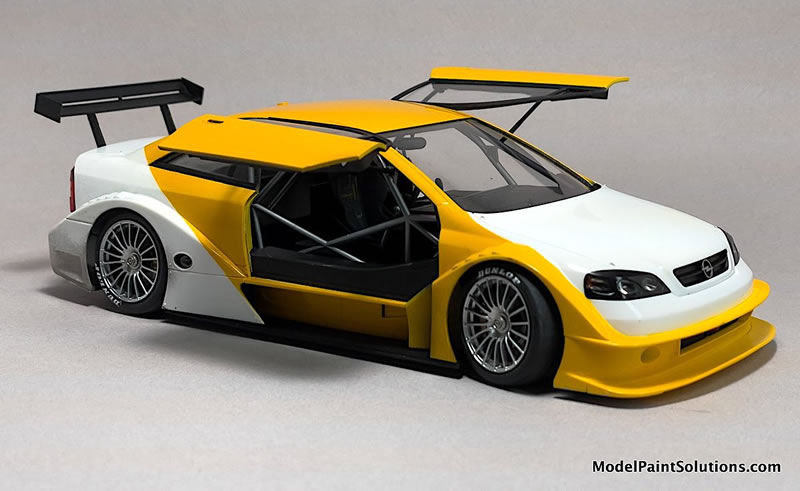
I did a bit of weathering by airbrushing what would be tire debris and exhaust soot on the body. I used a mix of Tamiya Panel Accent black and brown very lightly airbrushed using a Harder & Steenbeck Infinity using a .15 needle at around 10-12 PSI.
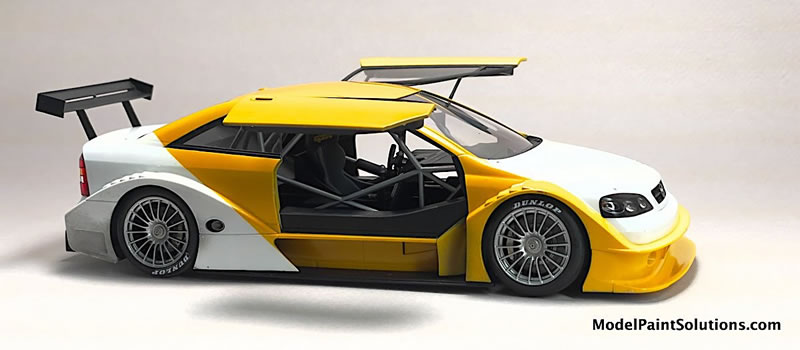
All-in-all this one turned out pretty good. I love the paint scheme. The wheels and tires are particularly great looking in my opinion. It's the little things that add up to cool looking model.

With this kit, I broke my run of unrewarding builds. One of the most helpful things was realizing that I really needed to enhance my close-up vision. I wear prescription glasses with progressive lenses, but that just isn’t good enough. I found that using my prescription reading glasses with magnifier glasses over them really improved my airbrushing and finishing work. If you haven't tried this, it may shock you when you look at your build close up, but it will certainly improve your final product.
Thanks for reading along!
Brad
For more on this review visit Modelpaintsolutions.com.
https://modelpaintsol.com/builds/tamiya-opel-astra-v8-coupe
Text & Images Copyright © 2024 by Brad Huskinson
Page Created 31 May, 2024
Last updated
1 June, 2024
Back to HyperScale Main Page
Back to Reviews Page

|
Home
| What's New |
Features |
Gallery |
Reviews |
Reference |
Forum |
Search